1972 Half Dollar Coin Value: How Much Is It Worth?
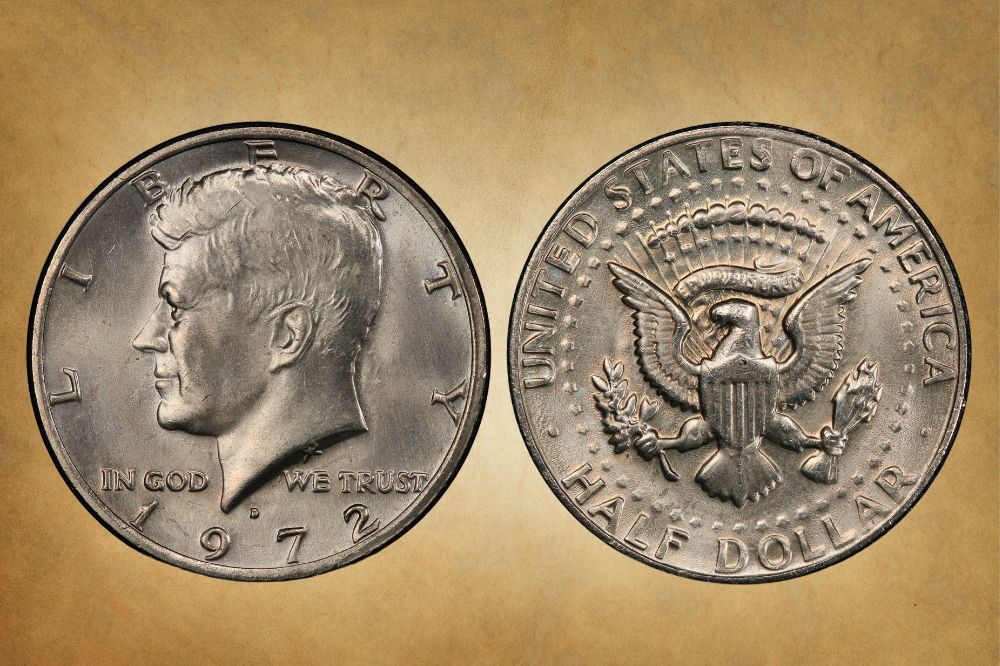
The half dollar is a 50-cent coin that has gone through numerous changes throughout its lifetime. It first appeared in 1794, and its current version features JFK – John Fitzgerald Kennedy. And the 1972 Half Dollar is a JFK as well. Let’s look into the background of this often neglected denomination so we can reliably validate the true 1972 Half Dollar Value.
1972 Half Dollar Value Chart |
|||||
| Mint Mark | Good (G 4) | Fine (F 12) | Extremely Fine (EF 40) | Uncirculated (MS 60) | Mint State (MS 65) |
| 1972 ‘P’ No Mint Mark Half Dollar Value | $0.50 | $0.50 | $0.50 | $2.28 | $2.28 |
| 1972 S Half Dollar Value | $0.50 | $0.50 | $0.50 | $2.28 | $5.70 |
| 1972 D Half Dollar Value | $0.50 | $0.50 | $0.50 | $2.28 | $15.00 |
1972 Half Dollar Value Guide
Special sets of the Kennedy have dollar were made in pure silver or pure gold (.9999), while some collector’s editions were minted in 90% silver. But the 1972 half-dollar was a regular edition with a core of 91.67% copper and a top coat of 8.33 nickel. So let’s analyze its value.
1972 No Mint Mark Half Dollar Value
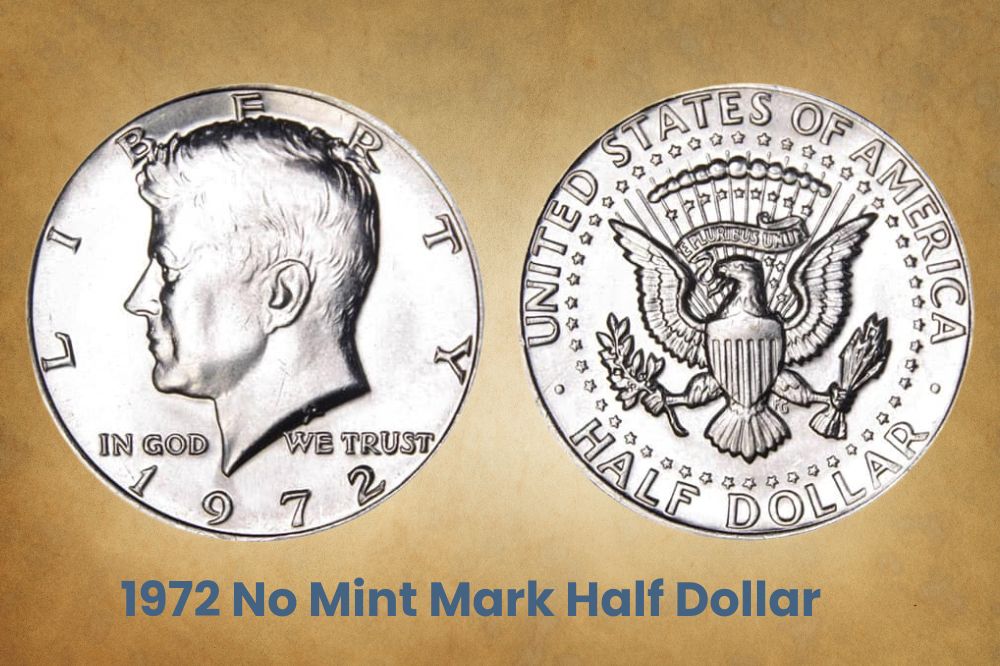
Over 150M half dollars were released from the Philadelphia mint in 1972. But like the other JFK half dollars, most were hoarded and later melted, so not many exist in graded condition. This makes them tough to evaluate. Most 1972 ‘P’ (No Mint Mark) coins are only worth their face value of 50 cents, though in MS 67, you can get as much as $1,000 for one of these coins.
1972 S Half Dollar Value
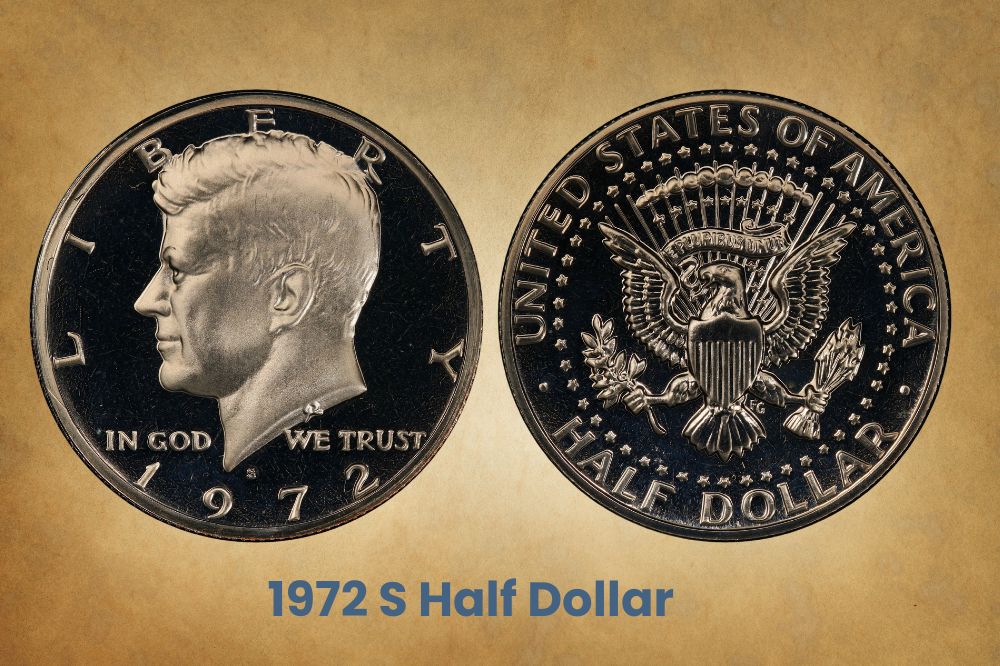
In 1972, all the half dollars that came out of San Francisco were proofs. Proof coins are struck on burnished planchets with a mirrored field and a frosted device. This gives the first 50 to 100 coins a cameo finish with intense contrast. A 1972 PR 65 half dollar can sell for $5.70. And if you find a 1972 S Deep Cameo in PR 69 without errors, it’s only worth $125.
1972 D Half Dollar Value
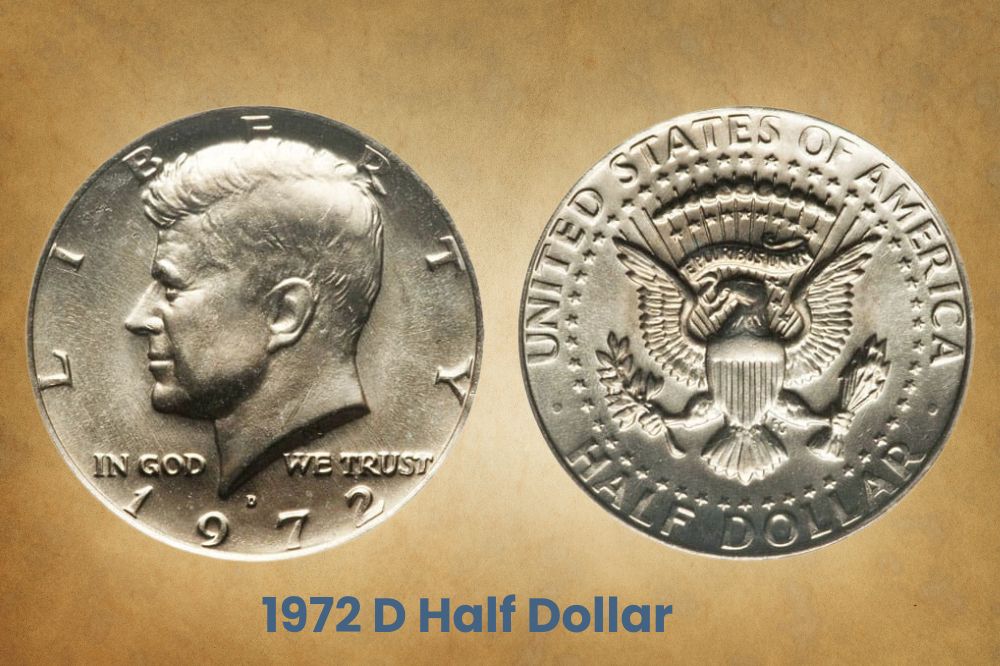
In 1972, close to 150M half dollars came out of Denver, slightly less than the volumes from the Philadelphia Mint. Most of these coins are only worth their 50-cent face value. But some copies don’t have FG on the reverse, and those can sometimes earn a premium. In 2016, a no-FG 1972 D Half Dollar sold for $2,485.13. In February 2020, an MS 64+ sold for $7,500.
Related Posts: 26 Most Valuable Half Dollar Coins In Circulation
1972 Half-Dollar Errors
If you get a weird-looking coin in your change, you might throw it away thinking the damage makes it worthless. Don’t!! Coin errors can sometimes raise the price of a coin by hundreds or even thousands of dollars! Let’s explore some of the common errors in 1972 half dollars.
1972 Half Dollar DDO Error
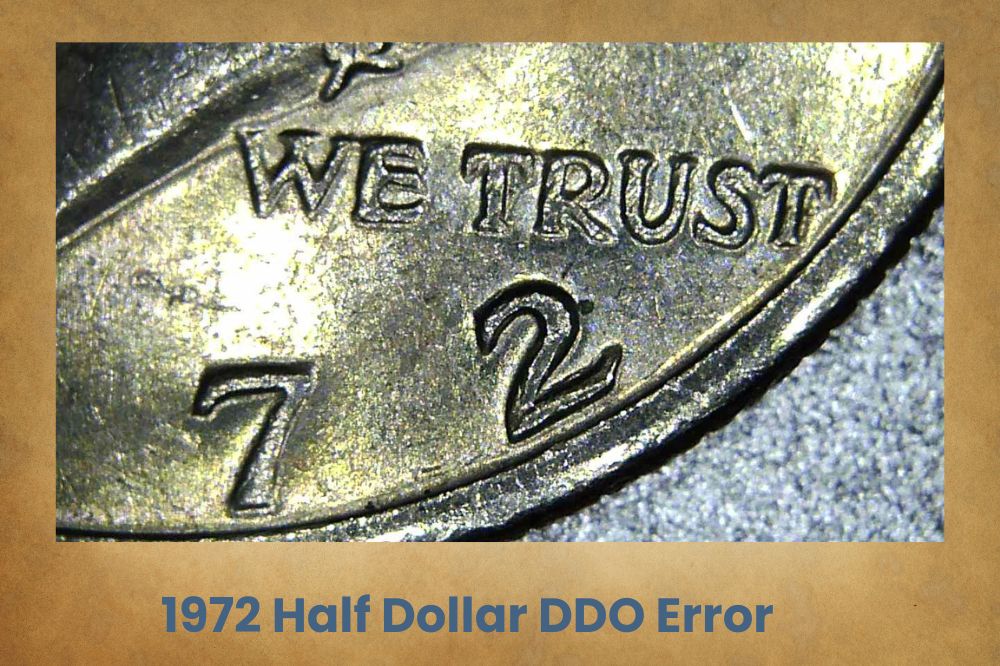
A double die obverse error (DDO) happens when the heads side of the die shifts during the hubbing process. This variety shows doubling on the lower front of the coin, particularly on the legend In God We Trust and on the minting year. Check the letters I, N, U, and T with a loupe. This error in MS 63 is worth $150. It jumps to $225 for MS 66 and $450 for MS 67.
1972 Half Dollar Struck on a Penny Planchet
Pennies used to be 95% copper before 1982 when they changed to 97.5% Zinc with a top coat of 2.5% copper. So a penny planchet from 1972 would be copper-toned in addition to being smaller than a half-dollar planchet. That makes the error fairly easy to spot since the error coin is both smaller and lighter. The coin will look like it was minted significantly off-center.
1972 Half Dollar Struck on a 5c Planchet
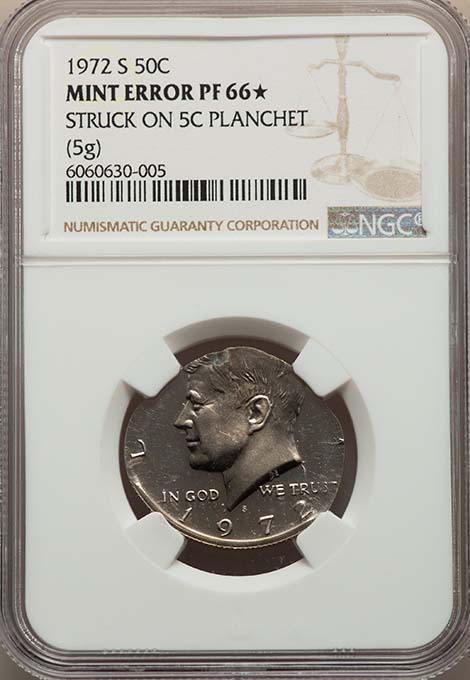
As we keep saying, the 1972 half-dollar is 91.67% copper and 8.33% nickel. Conversely, the 1972 nickel is 75% copper and 25% nickel. Visually, the coloring of the coins is the same, but size-wise, the half-dollar measures 30.61mm across while the nickel’s diameter is only 21.21mm. So a half dollar struck on a 5c planchet would appear truncated and off-center.
1972 Half Dollar Struck on a 25c Planchet
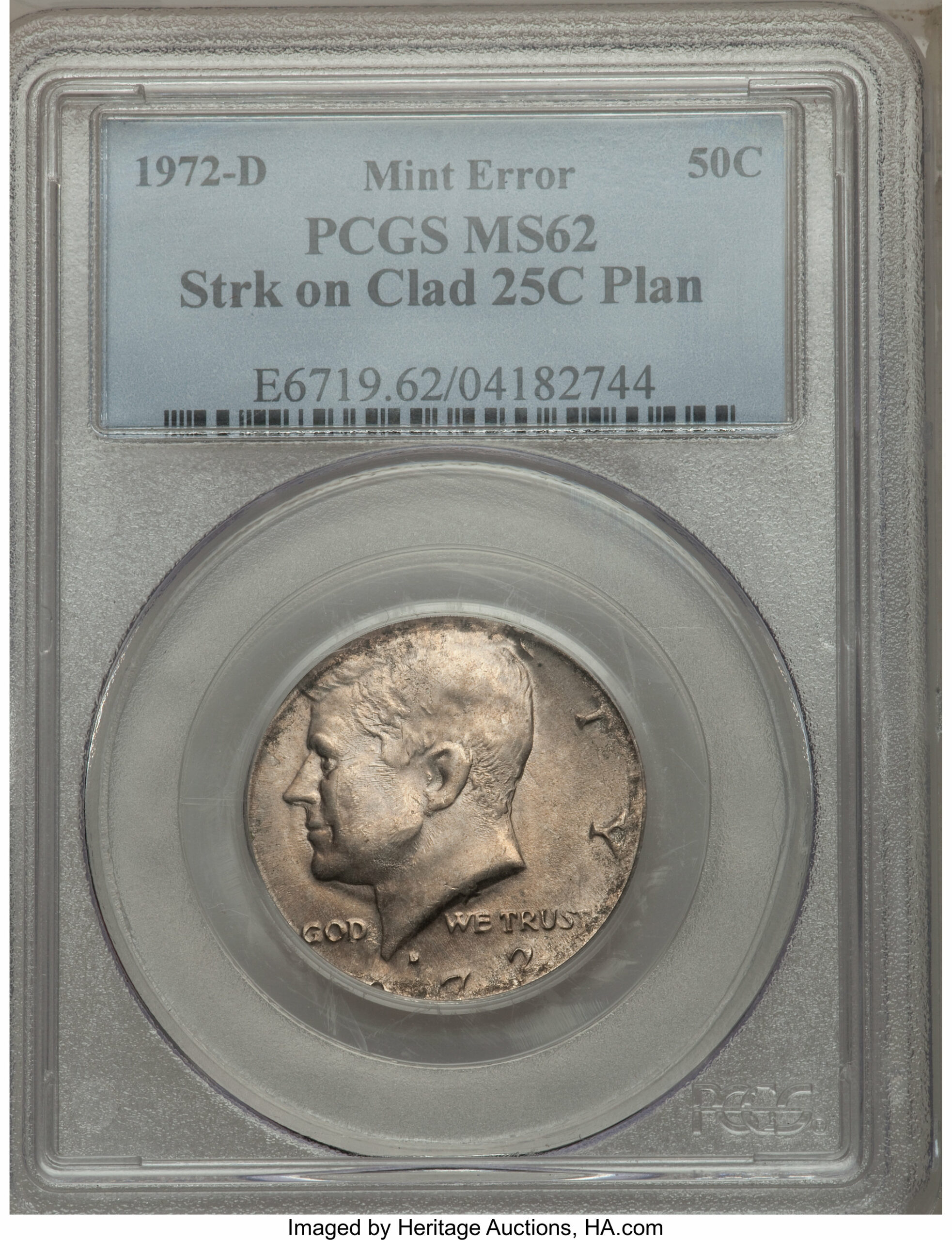
1972 is only a few years after the coin shortage and all the drama that went with it. And by this time, many circulating coins were minted using the Johnson Sandwich of 75% copper cores and 25% nickel plating. It was named for Lyndon B. Johnson, the 36th US President, in response to silver stacking hoarders. This mis-denominated 50c coin looks way off-center.
1972 Half Dollar Missing Clad Layer Error
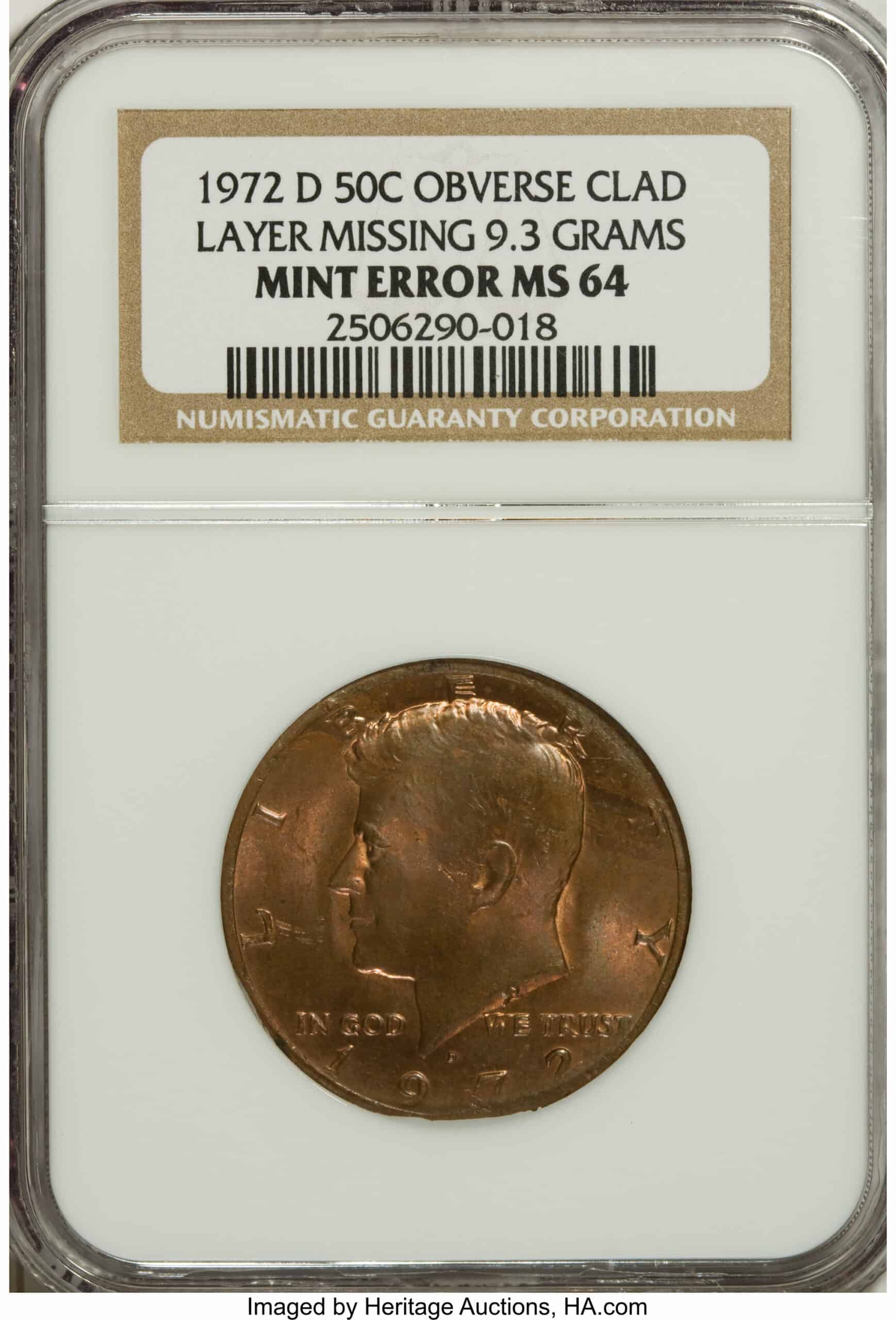
These coins aren’t just copper on the inside and nickel on the outside. Usually, the outermost layers of the coin (i.e. the front and back) are 75% copper and 25% nickel while the interior layer is pure copper. That’s how you end up with 91.67% copper and 8.33% nickel. This error omits the top layer that contains nickel, so the coin resembles an unusually oversized penny.
1972 Half Dollar Clipped Planchet Error
This coin is easy to spot if it appears in your change, but it’s harder to explain how the error occurred. It’s unlikely the error happened at the mint because someone would have seen it and removed it from the batch. Either way, a clipped coin error is when a section of the coin gets chopped or sliced off. On this coin, the upper left (Kennedy’s nose and face) is missing.
1972 Half-Dollar Off-Centre Strike Error
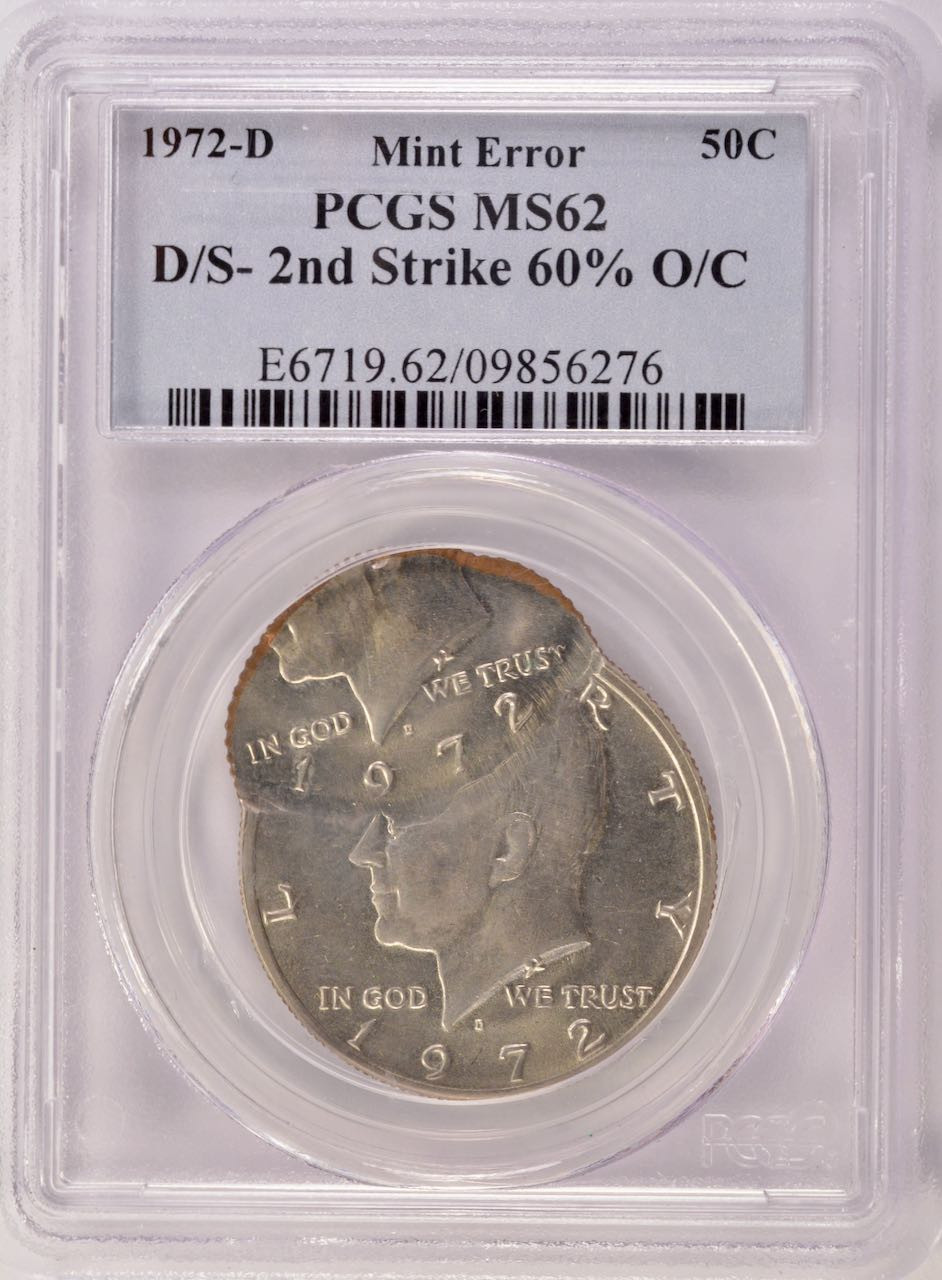
To ensure all the details of a coin’s design are clearly rendered, the die, the hub, and the planchet all have to be struck multiple times. And if any of these metal discs move between strikes, you’ll get a doubling, tripling, or quadrupling error, so some features will have a ‘shadow’ or ‘twin’. If the shift is drastic, you’ll get off-center errors that could be 5% to 95%.
1972 D Half Dollar No FG Error
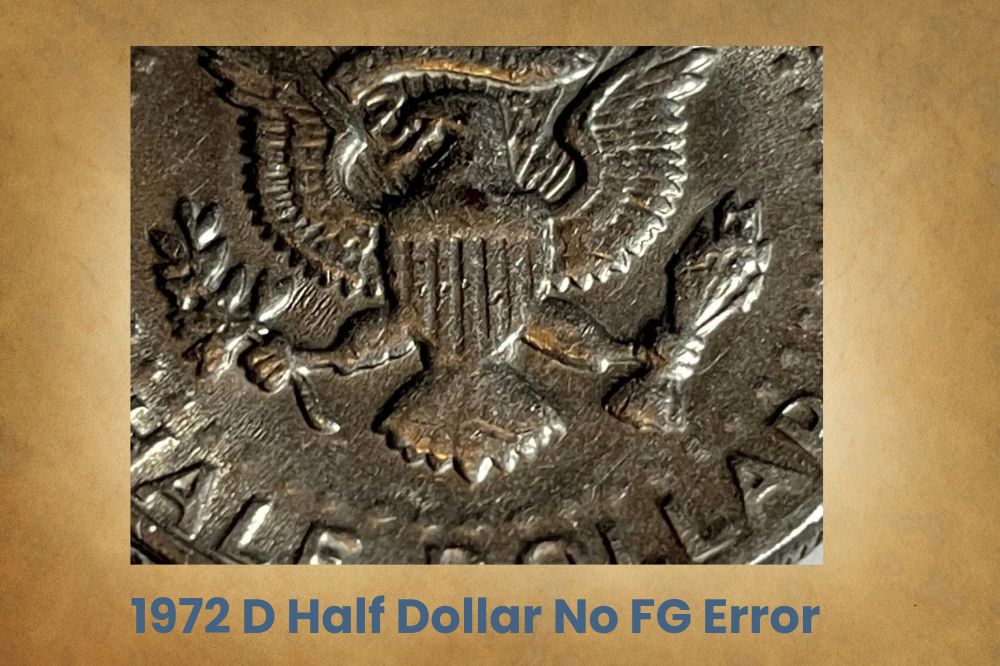
Usually, the FG (for Frank Gasparro) sits on the reverse, between the eagle’s right leg and its tail. Without the error (i.e. if the FG is present), this coin sold for $1,645 in MS 67+, and only 3 exist. But on many copies, the die was over-polished so the coin was minted without the FG. In AU 58, this coin has sold for $1,292.50. The same error in MS 63 sold for $2,485.13.
Related Posts: 17 Most Valuable Kennedy Half Dollar Worth Money
History of the 1972 Half Dollar
Over the years, the half dollar has had multiple designs including Flowing Hair, Draped Bust, Capped Bust, Seated Liberty, Barber, Walking Liberty, Franklin, and finally, the famous Jack Kennedy Half Dollar. The half dollar is a bulky coin, and it’s mostly used for slot machines.
The Kennedy Half Dollar was an urgent brief, so the mint used previously existing designs from the Presidential Medal. JFK had approved these designs before his death, so there was no disagreement on his depiction. Except one from his widow, who we fondly call Jackie O.
She didn’t like the hairline, so the coin was minted in two variants based on her comments. But as silver prices shot up, people hoarded silver coins for their melt value. Others hoarded the coins for sentimental reasons because the recently departed JFK was such a beloved soul.
This 1960s coin shortage made the mint adopt clad coins. The half dollar stayed silver at first though its proportion dropped from 90% to 40% in 1965. By 1971, all silver was extracted, leaving a coin that was mostly copper with a thin layer of nickel to mimic that silver surface.
The mint stopped making trade half dollars in 2001, and after 2002, they only produced collector’s editions. But while the coins aren’t seen in circulation very often, large volumes exist in bank vaults and at the mint. So as an amateur coin dealer, you can order coin rolls.
It’s a useful entry point for beginners since you can look for valuable errors or editions. And you can return whatever you don’t use, so there’s no loss on your part. A curious point is that some Denver half dollars had Gasparro’s initials accidentally buffed off. They’re worth more.
Related Posts: 18 Most Valuable Franklin Half Dollars Worth Money
how to identify 1972 Half Dollar?
Half dollars were so uncommon in circulation that the mint stopped making them for public use in 2002, though production officially resumed in 2021. But let’s focus on the 1972 half-dollar. A total of 295,070,000 half dollars were coined that year, so let’s check out the specs.
The Obverse of the 1972 Half Dollar
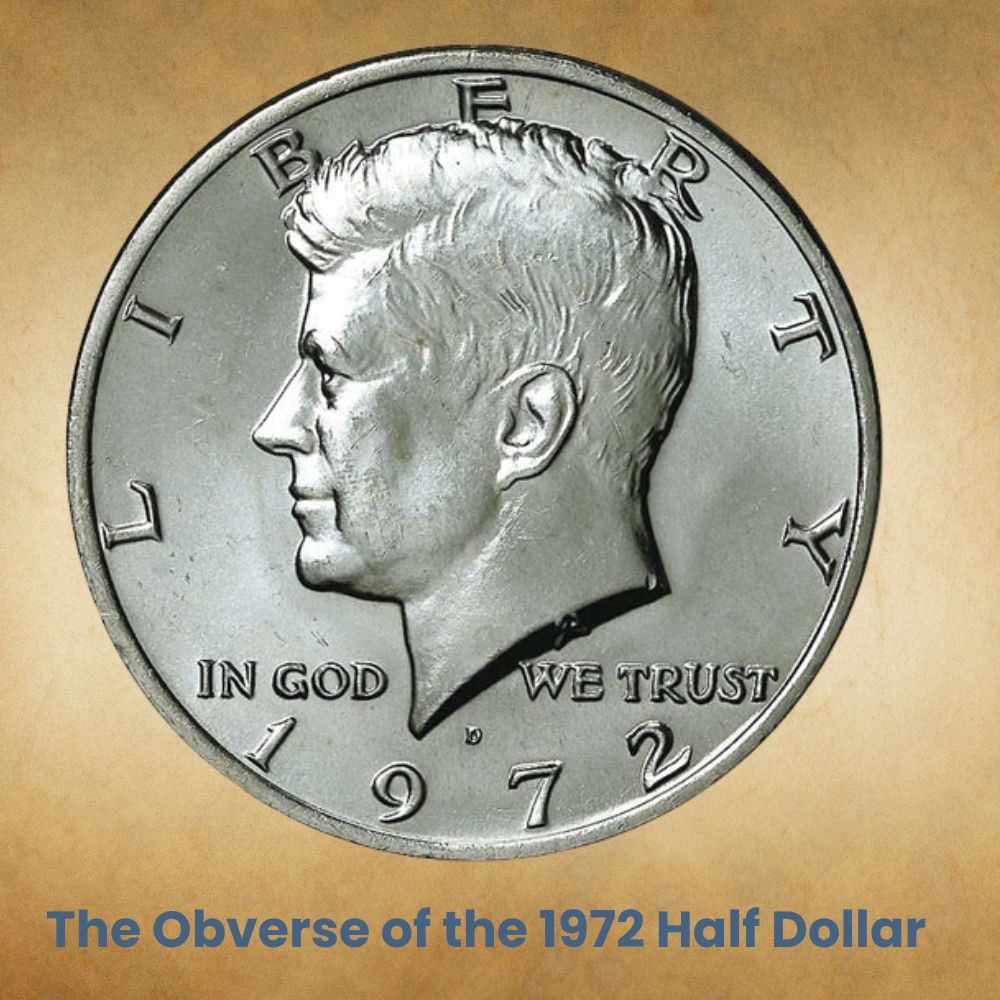
The obverse (heads side) of the 1972 Half Dollar features a profile portrait of John F. Kennedy, the 35th President of the United States. Most people called him Jack or JFK. He popped onto the coin in 1964, a year after the admired leader was assassinated. His image faces left, with Liberty curved around his head and the minting year along the lower collar.
The mint mark appears directly above the mintage year, and the designer’s initials (GR) are hidden under JFK’s neckline. In God We Trust is stamped on the sides of his neck, with In God on the left and We Trust on the right. The obverse was designed by Gilroy Roberts in 1964. He was the Chief Mint Engraver from 1948 to 1964, so it was sort of his parting gift.
The Reverse of the 1972 Half Dollar
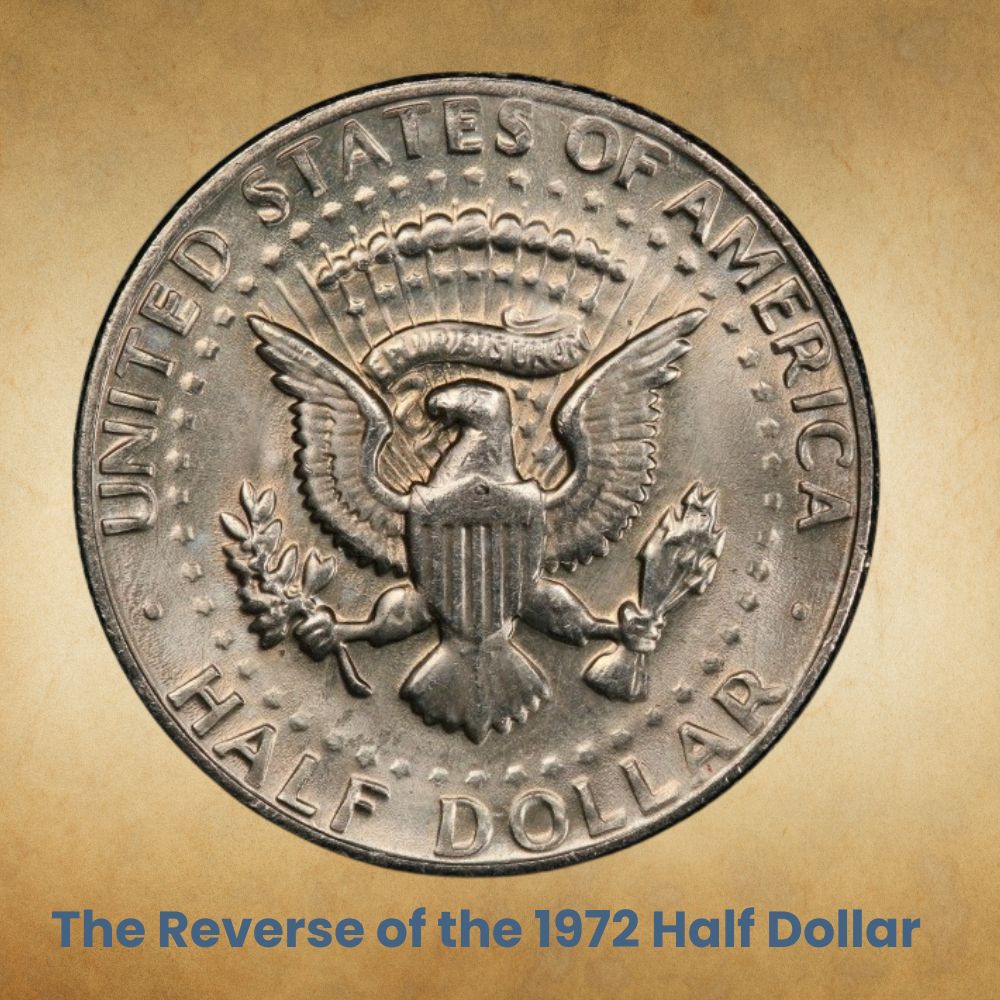
The reverse (tails side) of the 1972 Half Dollar bears the Official Seal of the United States President. The seal is an eagle with 13 arrows in one claw, an olive branch in the other, and a shield covering its chest. It’s circled by 50 stars with 13 more dotting the inner part of the seal, which has light rays and a banner or ribbon that says E Pluribus Unum near its head.
The seal also has 13 puffs of cloud. This reverse was designed by Frank Gasparro, the Chief Mint Engraver from 1965 to 1981. His initials – FG – appear above the tail on the right. United States of America is written along the upper collar while the denomination, Fifty Cents, runs along the lower collar. The coin has two dots that help separate the two legends.
Other Features of the 1972 Half Dollar
At 1.205” in diameter (30.61mm) and weighing 11.34g, the half dollar is the biggest US coin that’s currently in circulation. It’s 0.085” thick (2.16mm) and has 150 reeds along its edge. The coin has had various metal mixes including 90% silver and 10% copper in 1964, followed by a mix of 60% copper and 40% silver from 1965 to 1971. Today’s 50c is clad cupro-nickel.
Its current composition is 91.67% copper and 8.33% nickel. 153,180,000 half dollars came out of Philadelphia and had no mint marks, while 141,890,000 carried the D mint mark for Denver. But in 1972, the San Francisco Mint only produced proofs. They released 3,260,996 half-dollar proofs with the S mint mark. Fun fact – the 50th anniversary half dollar was gold!
What Makes a 1972 Half-Dollar Rare?
All Kennedy Half Dollars are rare because people silver stacked them for the melt value, and also for sentimental reasons. The pre-1971 coins are even rarer because of their silver content, but even 1972 clad coins were hoarded, probably out of habit. They’re tough to find in the wild, though the banks and mints admittedly have billions of 50c coins in their vaults.
Is a 1972 Kennedy Half Dollar Silver?
No. Coins from 1964 were 90% silver, and from 1965 to 1970 they were 40% silver, but Kennedy half dollars from 1971 onward were clad with 91.67% copper and 8.33% nickel. Only special edition half dollars came in pure silver or gold, and the mint didn’t make any in 1972.
Are Kennedy Half Dollars Worth More Than Face Value?
Not really. When they were first minted, many of these coins were hoarded, and when silver prices went up, the bulk of them were melted for bullion. When silver rates came down again, Kennedy half dollars started reappearing. But you’re unlikely to get more than $15 for a 1972 Kennedy Half Dollar. Most are only worth face value, though error coins cost more.

Tengo una moneda de 50 de kennedy está bien cuidada quisiera saber el valor